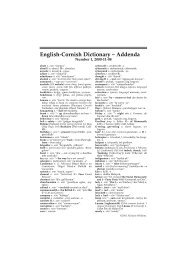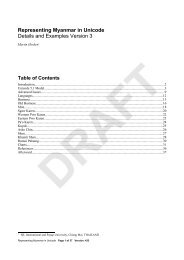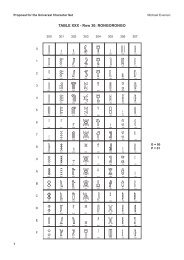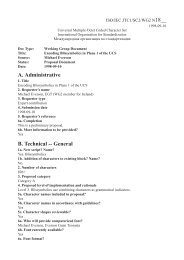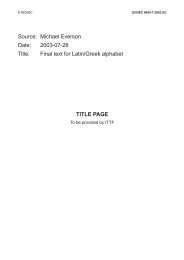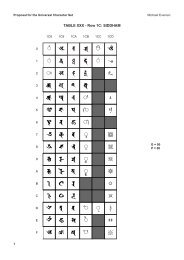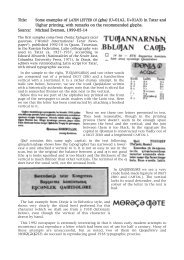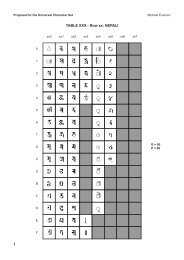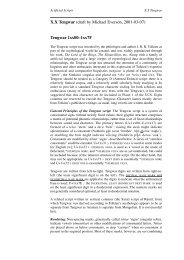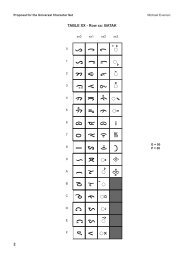ISO/IEC JTC1/SC2/WG2 N3194 L2/06-xxx - Evertype
ISO/IEC JTC1/SC2/WG2 N3194 L2/06-xxx - Evertype
ISO/IEC JTC1/SC2/WG2 N3194 L2/06-xxx - Evertype
You also want an ePaper? Increase the reach of your titles
YUMPU automatically turns print PDFs into web optimized ePapers that Google loves.
3. Information on the user community for the proposed characters (for example: size, demographics, information technology use, or<br />
publishing use) is included?<br />
Slavicists, Uralicists, Turkicists, Caucasianists, and other scholars and people interested in Slavonic ecclesiastics.<br />
4a. The context of use for the proposed characters (type of use; common or rare)<br />
Used historically and liturgically.<br />
4b. Reference<br />
5a. Are the proposed characters in current use by the user community?<br />
Yes.<br />
5b. If YES, where?<br />
Scholarly and religious publications.<br />
6a. After giving due considerations to the principles in the P&P document must the proposed characters be entirely in the BMP?<br />
Yes.<br />
6b. If YES, is a rationale provided?<br />
Yes.<br />
6c. If YES, reference<br />
Accordance with the Roadmap. Keep with other Cyrillic characters.<br />
7. Should the proposed characters be kept together in a contiguous range (rather than being scattered)?<br />
No.<br />
8a. Can any of the proposed characters be considered a presentation form of an existing character or character sequence?<br />
No.<br />
8b. If YES, is a rationale for its inclusion provided?<br />
8c. If YES, reference<br />
9a. Can any of the proposed characters be encoded using a composed character sequence of either existing characters or other proposed<br />
characters?<br />
No.<br />
9b. If YES, is a rationale for its inclusion provided?<br />
9c. If YES, reference<br />
10a. Can any of the proposed character(s) be considered to be similar (in appearance or function) to an existing character?<br />
Yes.<br />
10b. If YES, is a rationale for its inclusion provided?<br />
Yes.<br />
10c. If YES, reference<br />
See discussion at QA and WE.<br />
11a. Does the proposal include use of combining characters and/or use of composite sequences (see clauses 4.12 and 4.14 in <strong>ISO</strong>/<strong>IEC</strong><br />
1<strong>06</strong>46-1: 2000)?<br />
No.<br />
11b. If YES, is a rationale for such use provided?<br />
11c. If YES, reference<br />
11d. Is a list of composite sequences and their corresponding glyph images (graphic symbols) provided?<br />
No.<br />
11e. If YES, reference<br />
12a. Does the proposal contain characters with any special properties such as control function or similar semantics?<br />
No.<br />
12b. If YES, describe in detail (include attachment if necessary)<br />
13a. Does the proposal contain any Ideographic compatibility character(s)?<br />
No.<br />
13b. If YES, is the equivalent corresponding unified ideographic character(s) identified?<br />
52





